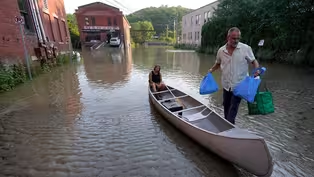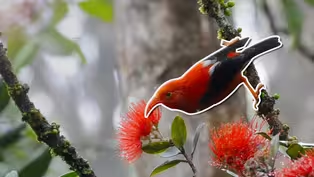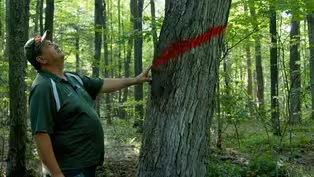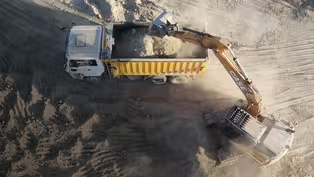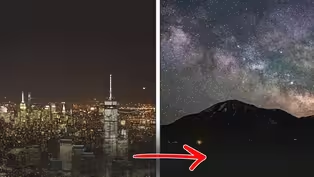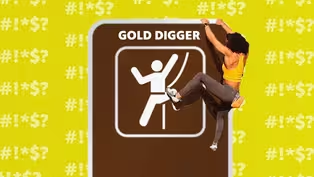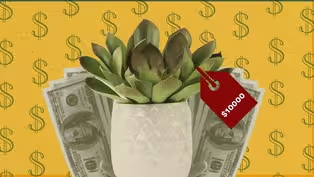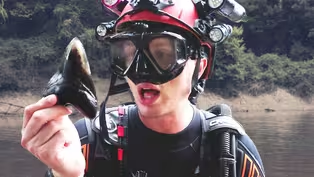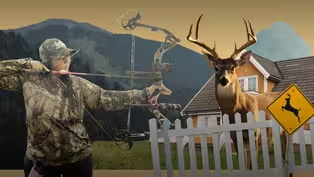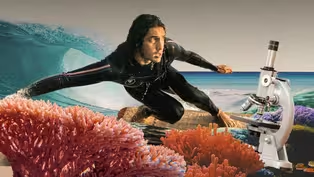
Understory | Can Dam Demolition Save California's Salmon?
Special | 11m 54sVideo has Closed Captions
What happens when you remove dams that changed the Klamath River a hundred years ago?
A hundred years ago the Klamath River was dammed and diverted, changing the landscape and the salmon population. Now, those same dams are being torn down. What will letting the river run wild mean for the water, the fish and the people who live there?
Problems playing video? | Closed Captioning Feedback
Problems playing video? | Closed Captioning Feedback
Major support is provided by Anne Ray Foundation, a Margaret A. Cargill Philanthropy and the Richard King Mellon Foundation. Support is also provided by John and Ruth Huss, Susan and...

Understory | Can Dam Demolition Save California's Salmon?
Special | 11m 54sVideo has Closed Captions
A hundred years ago the Klamath River was dammed and diverted, changing the landscape and the salmon population. Now, those same dams are being torn down. What will letting the river run wild mean for the water, the fish and the people who live there?
Problems playing video? | Closed Captioning Feedback
How to Watch America Outdoors with Baratunde Thurston
America Outdoors with Baratunde Thurston is available to stream on pbs.org and the free PBS App, available on iPhone, Apple TV, Android TV, Android smartphones, Amazon Fire TV, Amazon Fire Tablet, Roku, Samsung Smart TV, and Vizio.
Buy Now
Providing Support for PBS.org
Learn Moreabout PBS online sponsorshipMore from This Collection
How does our country’s diverse landscape shape our experience of the outdoors? That’s the central question behind the new PBS digital series, America Outdoors: Understory. Join host, Baratunde Thurston, as he explores the unexpected places and ways Americans encounter nature, and how their time outside is impacted by climate change, equity, access, outdoor culture and more.
Understory | Climate Change's Effects on Vermont Flooding
Video has Closed Captions
Discover the science behind this summer’s historic and devasting floods in Vermont. (13m)
Understory | How Engineered Mosquitos Could Save Birds
Video has Closed Captions
Discover how bacteria could be the key to stopping mosquito-borne illnesses. (11m 37s)
Understory | Can Ancient Wisdom Save the Forests?
Video has Closed Captions
Forests are in trouble, but could ancient wisdom be the answer to saving our trees? (11m 54s)
Understory | We’re Running Out of Sand
Video has Closed Captions
Sand may seem unremarkable, but the modern world is built on it and we’re running out. (13m 7s)
Understory | The Movement to Save Our Night Skies
Video has Closed Captions
Explore one small town’s mission to save the night sky and help migrating birds. (12m 59s)
Understory | Rock Climbing's Troubled Route Naming Tradition
Video has Closed Captions
Baratunde meets a rock climber who is working to diversify the sport. (8m 48s)
Understory | How the Houseplant Boom Fueled Plant Poaching
Video has Closed Captions
Baratunde meets a plant parent who is bringing awareness to the issue of plant poaching. (7m 31s)
Understory | The Fossil Hunter Uncovering Florida’s Past
Video has Closed Captions
Baratunde meets a Florida fossil hunter and learns how this hobby contributes to science. (9m 11s)
Understory | Meet the Suburban Deer Hunters of Long Island
Video has Closed Captions
Baratunde meets a female suburban bowhunter to discuss how the sport is changing. (8m 35s)
Understory | The Scientist Surfing to Fight Climate Change
Video has Closed Captions
Baratunde meets a surfer scientist in Hawaii who is trying to protect the corals reefs. (10m 6s)
Providing Support for PBS.org
Learn Moreabout PBS online sponsorship(gentle pensive music) - [Baratunde] This is what a wild river looks like.
No dams, no canals, no diversion.
Just a river running wild like it's supposed to.
But these days a truly untamed river is practically a thing of the past.
We like to think that America is a land where rivers flow freely, but the truth may disappoint you.
The vast majority of our rivers are dammed, diverted or otherwise controlled.
But when I got to paddle the Suwannee River, the experience was indescribable.
I was truly in awe, and that awe made me wonder, "Is it possible to make a river wild again?"
To answer that question, we're traveling to Northern California where the Yurok tribe has been wondering a similar thing.
- [Baratunde] Oh yeah.
That one's kind of hard lugging around.
- [Barry] Yeah, just for you, it's good though, huh?
- [Baratunde] Just for me, it's perfect.
- So we're here at the estuary of the Klamath River, kind of just before it meets the Pacific Ocean.
There's a lot of activity here.
You look around here, you're gonna see marine mammals and birds, and every single fish that enters the Klamath River has to pass through this area right here.
- [Baratunde] Meet Barry McCovey, a biologist for the Yurok Tribe.
The Yurok are among the five tribes that have called the Klamath River and surrounding area home long before European settlers arrived.
- [Barry] The Yurok people, we believe that humans are also a part of this ecosystem.
We're intrinsically connected to this river.
It's just as important to Yurok people as the air we breathe.
- [Baratunde] This connection largely centers around one amazing creature.
Salmon.
Salmon has been at the heart of Yurok culture for hundreds of years.
- [Barry] We had this incredible source of food right in our backyards that we could access pretty easily for most of the year.
- Imagine most of your community's meals come from fishing in the pristine, beautiful waters of the Klamath.
For the Yurok, this was their reality.
They could always count on the salmon passing through.
- [Barry] So most salmon, they spend part of their life in freshwater and part of their life in saltwater.
They're born upstream.
They migrate out as juveniles into the Pacific Ocean and then they'll migrate back into the Klamath River and move upstream to spawn as adults.
And then the cycle starts again.
Every year in the spring, the summer, the fall, there was always abundant salmon runs and tribal people took advantage of that.
- [Baratunde] But about a century ago, settlers began to develop the Klamath River altering its natural flow to suit their needs.
Their goal was not just to channel the river's water for agriculture, but to harness its power for electricity.
To do that, they built seven hydroelectric dams.
That's seven massive structures placed in the path of the river For the Yurok that electricity came at a huge cost.
- [Barry] And so now the fish that used to be able to go to the upper basin to spawn, they came upstream and they ran into a dam.
Like that, the run size was probably cut in half.
- [Baratunde] And the situation only got worse.
Over the next few decades, the Klamath would continue to lose its salmon with some species declining by a whopping 98%.
This decline, it had a big effect on the Yurok people.
- We have to rely a lot more on outside sources for food which aren't as healthy.
We can see this direct correlation between the health of the Klamath River and the health of Yurok and other indigenous people on the Klamath River.
- [Baratunde] But this loss is about much more than just nutrition.
- For me, these salmon aren't just like a food you eat.
For me, it's losing a part of my ancestry, my history.
- [Baratunde] This is Brooke Thompson, a member of the Yurok and Karuk Tribes.
Brooke is well acquainted with the dangers of a dammed Klamath river.
- [Brooke] I was seven years old.
It was early in the morning, so I was with my dad and my mom, and you just heard people call out like, "Hey, you have to check out the river.
Something's going on."
And we came out to see what everyone was talking about.
There were just, as far as you could see down the river, there was just piles of dead salmon.
- [Baratunde] What Brooke was experiencing would go down in history as the "Klamath River Fish Kill of 2002".
That year, low water levels and poor water quality created the perfect conditions for a disease called gill rot to spread rapidly.
The results were disastrous.
- It was the biggest salmon die off in the history of the United States.
Upwards of 60 to 70,000 Chinook salmon and Coho salmon were dead and lining the banks of the Klamath River.
That kind of galvanized the community and the tribal communities in particular to say, "We have to do something about this.
We have to change this trajectory because the trajectory that we were on was extinction."
(indistinct) - [Crowd] Bring the salmon home.
- They say they'll work with us to bring the salmon home.
The question is, do they mean it this time?
- [Baratunde] And now more than 20 years later, there's another kind of disruption happening.
- US regulators approved a plan to demolish four dams on a California river.
- Four of those giant dams are coming down.
It's the largest dam removal project in history.
- [Mark] Simply amazing to be where we are today.
It's been a long time coming.
- [Baratunde] Mark Bransom is the CEO of the Klamath River Renewal Corporation which recently gained ownership of the four dams and is preparing for their removal.
- Removal of the dams is intended to accomplish several major goals.
One, these dams and reservoirs have created water quality impairments.
During the summer, the water in these reservoirs warms up and supports the growth of large blooms of toxic blue-green algae.
The water that moves through these reservoirs and pass these dams carries that toxin with them having direct impacts on the wildlife that utilize the river.
Secondly, is to restore fish passage so that these returning salmon can access that historic habitat in the upper parts of the watershed.
- It sounds like demolishing these dams should make life better for people and wildlife along the Klamath.
But this is a huge change and some people have serious doubts.
- I can tell you that everybody that moved up here bought a house here because they wanted to live on a lake.
It's a difficult transition for people to lose the lake.
- [Baratunde] Francis Gill and Danny Fontaine live at the water's edge.
They're residents of a lakefront community, a lake that was formed by the construction of one of the dams.
With about a hundred residents, Copco Lake was the perfect place for Danny and Francis to live out their dreams of small town life.
- Come on in.
Our plan was actually to make this into a really old looking general store and just have that feel of an old general store.
- [Baratunde] But since the decision to remove the dams, they worry that the community's future is in limbo.
- Everything is just so undetermined.
There's no answers.
There's no clear answers to anything or what anything will be like.
It's just a risk and a guess.
- [Baratunde] And it's not just Danny and Francis.
Many of their neighbors also worry about how this project will affect their lives.
The Klamath River Renewal Corporation admits some property owners around the river could experience troubling impacts from dam removal, impacts like changes to groundwater wells, homes settling or slumping, even a higher risk of flooding.
- Most people up here are very skeptical at best.
People are fearful of losing wildlife.
People are fearful of losing their property values.
- It's supposed to be the biggest dam removal in history.
Who knows what could happen?
I mean, if it's the first time anything that big has ever taken place, it kind of feels like an experiment and we're the Guinea pigs.
- [Baratunde] But many scientists who've studied this river believe that research exists which addresses the concerns of residents.
- Our goal as scientists is to be as transparent as possible.
Some of the fears that folks have about what might happen with dam removal have been thoroughly studied, thoroughly addressed by independent parties.
They've done a ton of analysis, a ton of modeling with expertise in the river and have been able to conclusively show that a lot of these fears are unfounded.
(upbeat music) - [Baratunde] Desiree Tullos is a professor of water resources engineering.
The work she and her team are doing is key to understanding what impact the dam removal project will have on the Klamath.
- [Desiree] Things we can say with confidence, the cyanobacterial blooms in the reservoirs will be gone.
The toxin levels in the river that we're standing in will drop.
We're very confident in that.
We also know that salmon are gonna move upstream beyond where they are currently.
Whether that translates into like large scale recovery of fish is an open question.
There's a fear, I think, sometimes among scientists, if we share that, "Hey, we're probably not gonna see this huge salmon run the year after dam removal," that people are gonna walk away from the basin or they're gonna think the dam removal was a failure.
But the reality is that we're talking about ecological timescales, not human timescales.
We have the the patience to know that it's not necessarily gonna happen within the first year, that it could take some time and it's gonna take more actions than just the dam removal.
- [Baratunde] When it comes to salmon, scientists remain optimistic.
Even as they admit that the future of the fish is uncertain, they expect one thing.
Removing the dam will improve water quality and that's beneficial to everyone.
Not only are property values expected to rise, the grass is literally looking greener.
- All that green right there is underwater and so when the water went down, it's been a few weeks, but it's just turning green.
If it all looks like that, it would be awesome.
- Sometimes it's so hard for me to wrap my mind around the puzzle of the dam removal.
At the end of the day, I want everyone in California to prosper.
We can find ways where we can all uplift each other - [Baratunde] So, will the river run wild again once the dams are gone?
The Klamath may never be fully restored to the way it was before it was developed.
But this is a monumental step in the right direction, bringing this river one step closer to its former self.
- [Barry] 20 years ago when we would mention we wanna remove the Klamath dams, we would get laughed out of the room.
To get here, it gives us hope, and it should give everyone hope.
Any crazy project or crazy idea that someone has that's gonna help restore balance and help fix an ecosystem, all they have to do is look at the Klamath and say, "Those guys did it.
We should be able to do it, too."
It's not just about restoring the Klamath River.
This whole idea is much bigger than that.
It's about fixing the earth.
- Thank you so much for watching.
For more inspiring stories of the great outdoors and our connection to nature, please check out season two of "America Outdoors" with Baratunde Thurston.
We're in the PBS video app, your PBS local station or click the link in the description below for access to a full episode and more information about the show.

- Science and Nature

Explore scientific discoveries on television's most acclaimed science documentary series.

- Science and Nature

Capturing the splendor of the natural world, from the African plains to the Antarctic ice.












Support for PBS provided by:
Major support is provided by Anne Ray Foundation, a Margaret A. Cargill Philanthropy and the Richard King Mellon Foundation. Support is also provided by John and Ruth Huss, Susan and...
